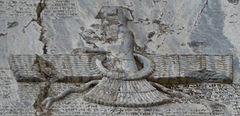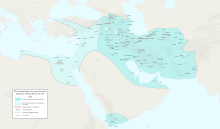
Back إيران الكبرى Arabic Gran Irán AST Böyük İran Azerbaijani Голям Иран Bulgarian Gran Iran Catalan Kalibotang Persyano CEB ئێرانی مەزن CKB İrano Gırd DIQ Granda Irano Esperanto Gran Irán Spanish
This article has multiple issues. Please help improve it or discuss these issues on the talk page. (Learn how and when to remove these messages)
|
 |
| History of Greater Iran |
|---|


Greater Iran or Greater Persia (Persian: ایران بزرگ Irān-e Bozorg), also called the Iranosphere or the Persosphere, is an expression that denotes a wide socio-cultural region comprising parts of West Asia, the Caucasus, Central Asia, South Asia, and East Asia (specifically the Tarim Basin)—all of which have been affected, to some degree, by the Iranian peoples and the Iranian languages.[1][2]
It is defined by having long been ruled by the dynasties of various Iranian empires,[note 1][3][4][5] under whom the local populaces gradually incorporated some degree of Iranian influence into their cultural and/or linguistic traditions;[note 2] or alternatively as where a considerable number of Iranians settled to still maintain communities who patronize their respective cultures,[note 3] geographically corresponding to the areas surrounding the Iranian plateau.[6][7] It is referred to as the "Iranian Cultural Continent" by Encyclopædia Iranica.[8]
Throughout the 16th–19th centuries, Iran lost many of the territories that had been conquered under the Safavids and Qajars.
The Ottoman–Iranian Wars resulted in the loss of present-day Iraq to the Ottoman Empire, as outlined in the Treaty of Amasya in 1555 and the Treaty of Zuhab in 1639.
Simultaneously, the Russo-Iranian Wars resulted in the loss of the Caucasus to the Russian Empire: the Treaty of Gulistan in 1813 saw Iran cede present-day Dagestan, Georgia, and most of Azerbaijan;[9][10][11] the Treaty of Turkmenchay in 1828 saw Iran cede present-day Armenia, the remainder of Azerbaijan, and Iğdır, setting the northern boundary along the Aras River.[12][13]
Parts of Afghanistan were lost to the British Empire through the Treaty of Paris in 1857 and the McMahon Arbitration in 1905.[14][15]
- ^ Frye, Richard Nelson (1962). "Reitzenstein and Qumrân Revisited by an Iranian, Richard Nelson Frye, The Harvard Theological Review, Vol. 55, No. 4 (Oct. 1962), pp. 261–268". The Harvard Theological Review. 55 (4): 261–268. doi:10.1017/S0017816000007926. JSTOR 1508723. S2CID 162213219.
- ^ International Journal of Middle East Studies. (2007), 39: pp 307–309 Copyright © 2007 Cambridge University Press.
- ^ Marcinkowski, Christoph (2010). Shi'ite Identities: Community and Culture in Changing Social Contexts. LIT Verlag Münster. p. 83. ISBN 978-3-643-80049-7.
- ^ "Interview with Richard N. Frye (CNN)". Archived from the original on 2016-04-23.
- ^ Richard Nelson Frye, The Harvard Theological Review, Vol. 55, No. 4 (Oct. 1962), pp. 261–268 I use the term Iran in an historical context[...]Persia would be used for the modern state, more or less equivalent to "western Iran". I use the term "Greater Iran" to mean what I suspect most Classicists and ancient historians really mean by their use of Persia—that which was within the political boundaries of States ruled by Iranians.
- ^ "IRAN i. LANDS OF IRAN". Encyclopædia Iranica.
- ^ Dialect, Culture, and Society in Eastern Arabia: Glossary. Clive Holes. 2001. Page XXX. ISBN 978-90-04-10763-2.
- ^
- "2008 Annual Report" (PDF). Encyclopædia Iranica. New York: Center for Iranian Studies, Columbia University. 2009. Archived (PDF) from the original on 2023-08-12. p. 5:
Covering a multi-lingual and multi-ethnic cultural continent, the Encyclopædia Iranica's scope encompasses all aspects of the life, history, and civilization of all the peoples who speak or once spoke an Iranian language
. - Boss, Shira J. (November 2003). "Encyclopaedia Iranica: Comprehensive research project about the "Iranian Cultural Continent" thrives on Riverside Drive". Columbia College Today. Vol. 30, no. 2. New York: Columbia College Office of Alumni Affairs and Development. pp. 32–33. ISSN 0572-7820. Archived from the original on 2021-02-15. Scan of print version available at Columbia College Today, v. 30 (2003–04) at the Internet Archive.
- Niknejad, Kelly Golnoush (2008-12-07) [first published March 2005]. "Encyclopaedia Iranica: an Iranian love story". Tehran Bureau. Frontline. PBS. Archived from the original on 2010-04-26.
- "2008 Annual Report" (PDF). Encyclopædia Iranica. New York: Center for Iranian Studies, Columbia University. 2009. Archived (PDF) from the original on 2023-08-12. p. 5:
- ^ India. Foreign and Political Dept. (1892). A Collection of Treaties, Engagements, and Sunnuds, Relating to India and Neighbouring Countries: Persia and the Persian Gulf. G. A. Savielle and P. M. Cranenburgh, Bengal Print. Co. pp. x (10).
treaty of gulistan.
- ^ Mikaberidze, Alexander (2015). Historical Dictionary of Georgia. Rowman & Littlefield. pp. 348–349. ISBN 978-1-4422-4146-6.
Persia lost all its territories to the north of the Aras River, which included all of Georgia, and parts of Armenia and Azerbaijan.
- ^ Olsen, James Stuart; Shadle, Robert (1991). Historical Dictionary of European Imperialism. Greenwood Publishing Group. p. 314. ISBN 978-0-313-26257-9.
In 1813 Iran signed the Treaty of Gulistan, ceding Georgia to Russia.
- ^ Roxane Farmanfarmaian (2008). War and peace in Qajar Persia: implications past and present. Psychology Press. p. 4. ISBN 978-0-203-93830-0.
- ^ Fisher et al. 1991, p. 329.
- ^ Erik Goldstein (1992). Wars and peace treaties, 1816-1991. Psychology Press. pp. 72–73. ISBN 978-0-203-97682-1.
- ^ Sir Percy Molesworth Sykes (1915). A history of Persia, Volume 2. Macmillan and co. p. 469.
Macmahon arbitration persia.
Cite error: There are <ref group=note> tags on this page, but the references will not show without a {{reflist|group=note}} template (see the help page).